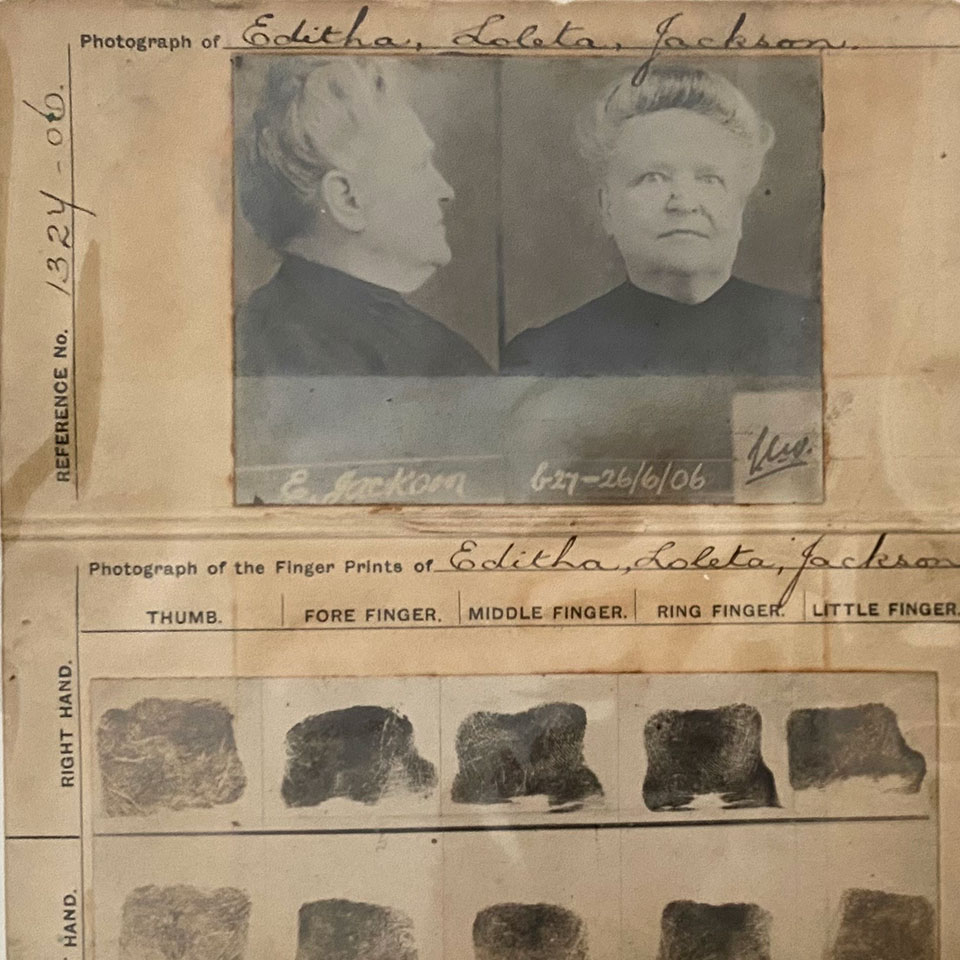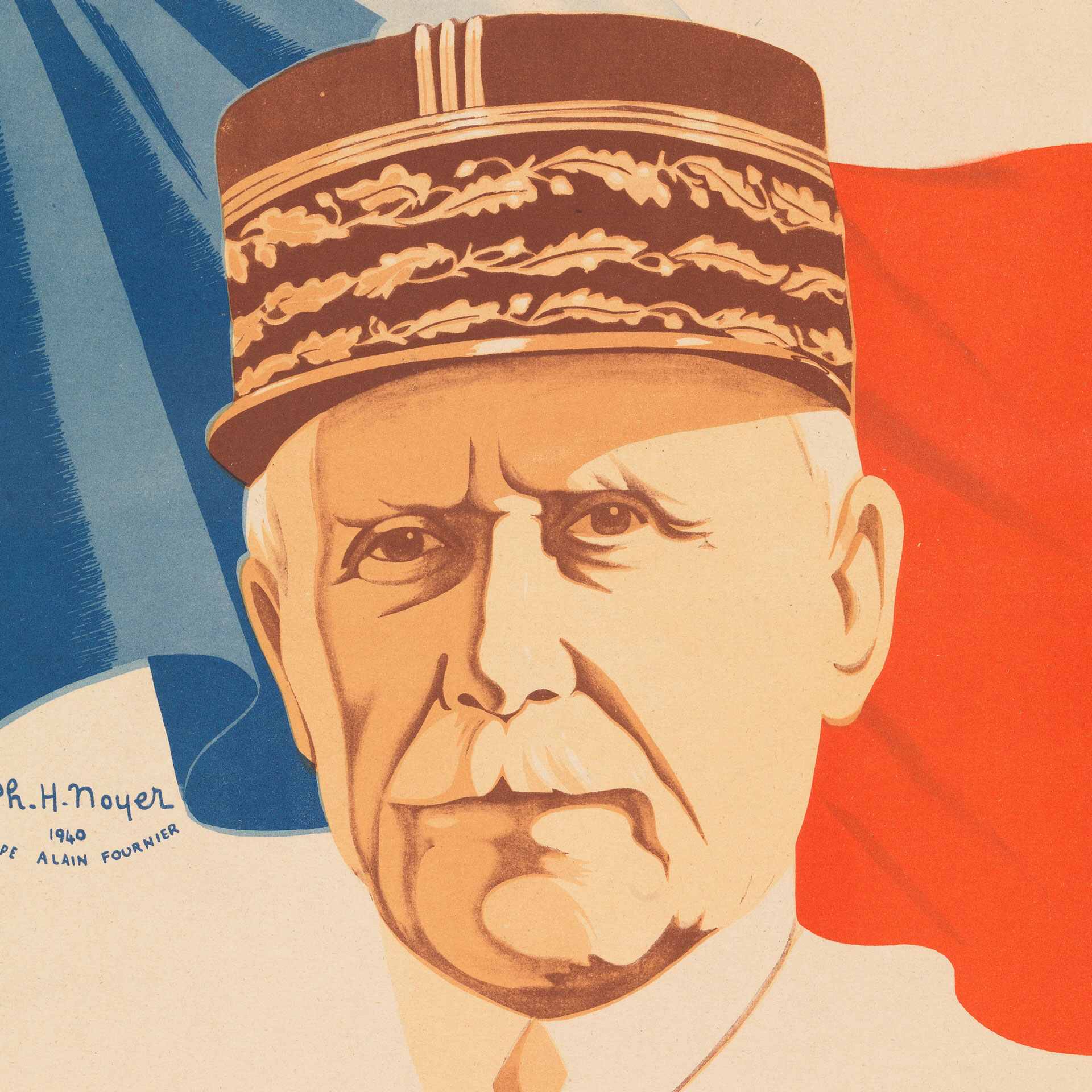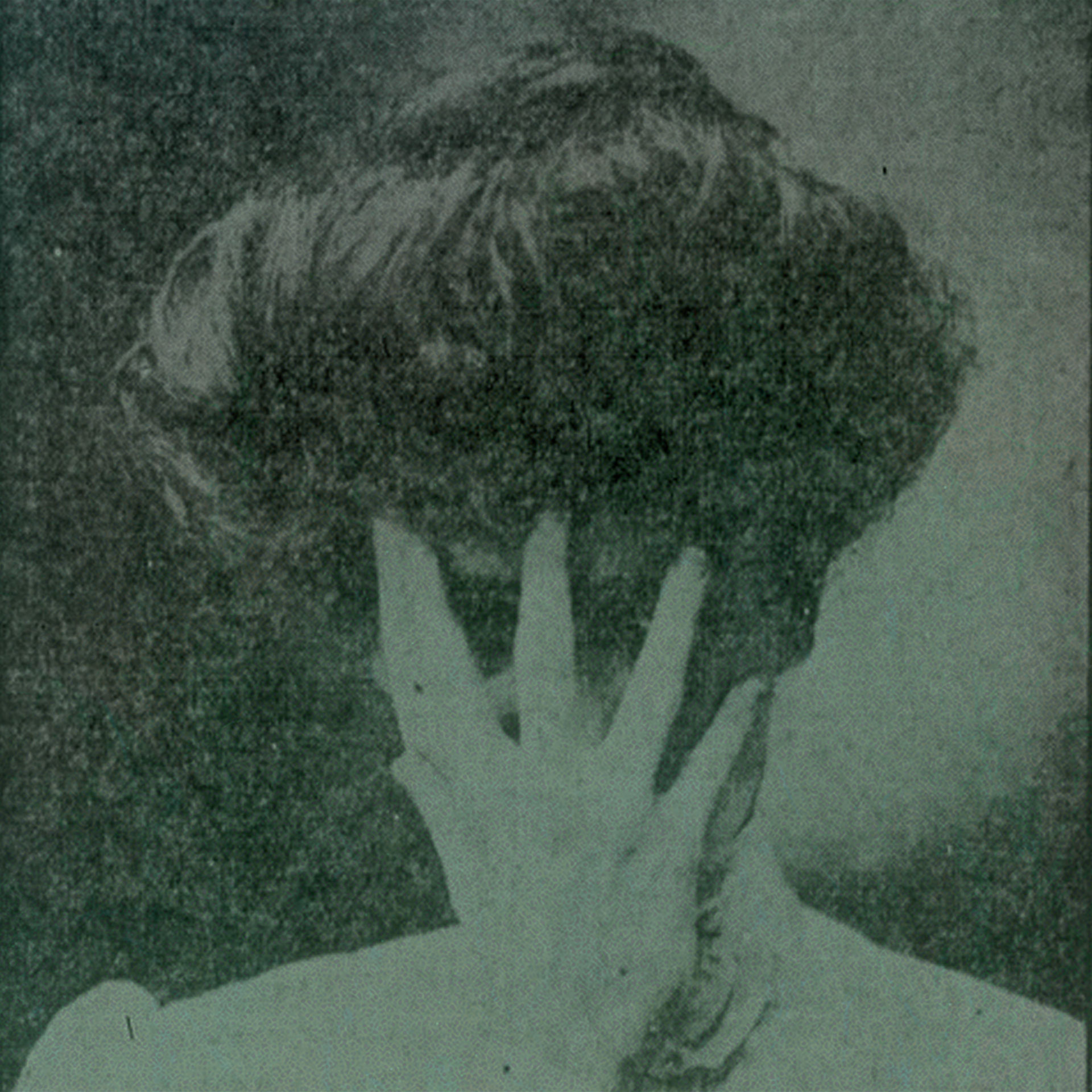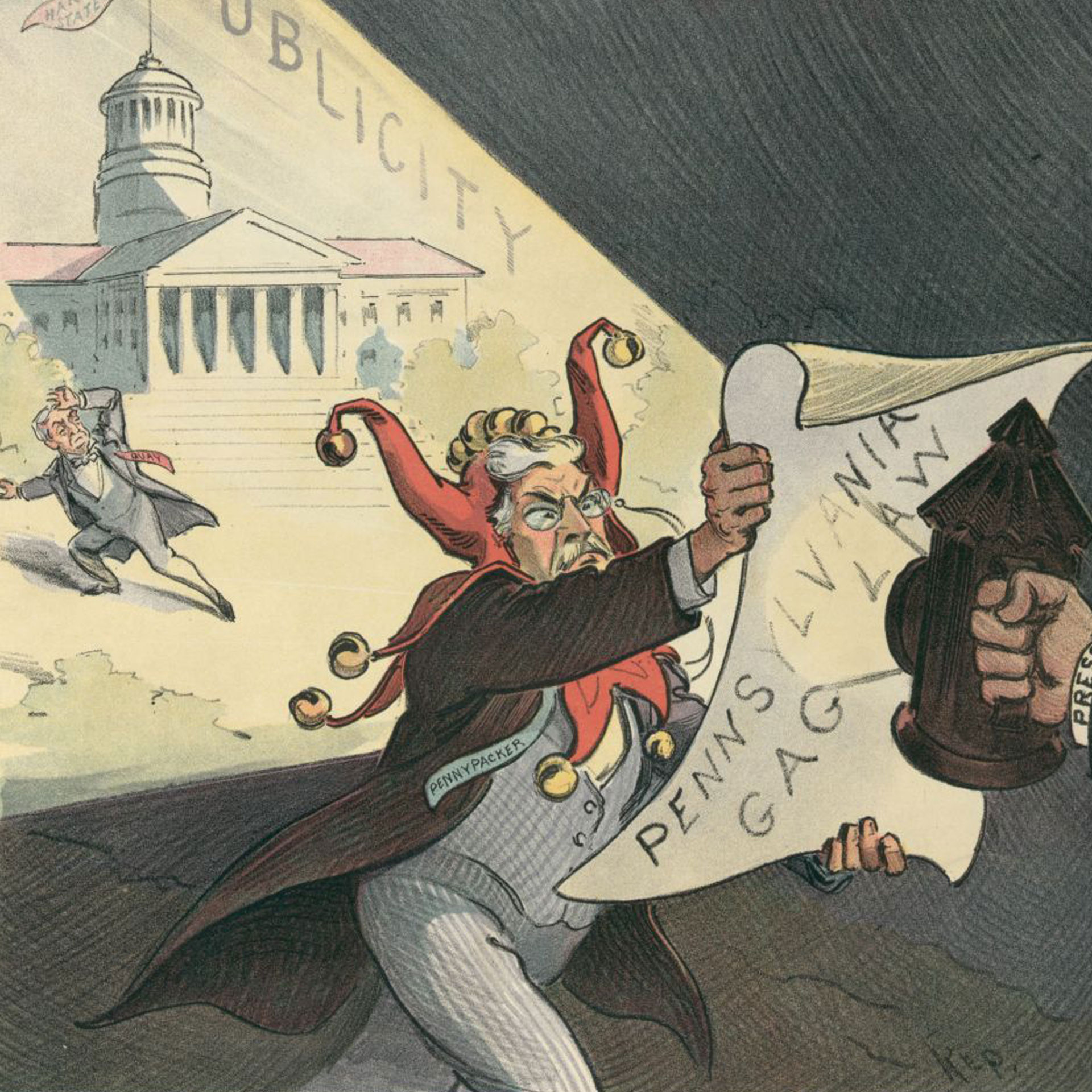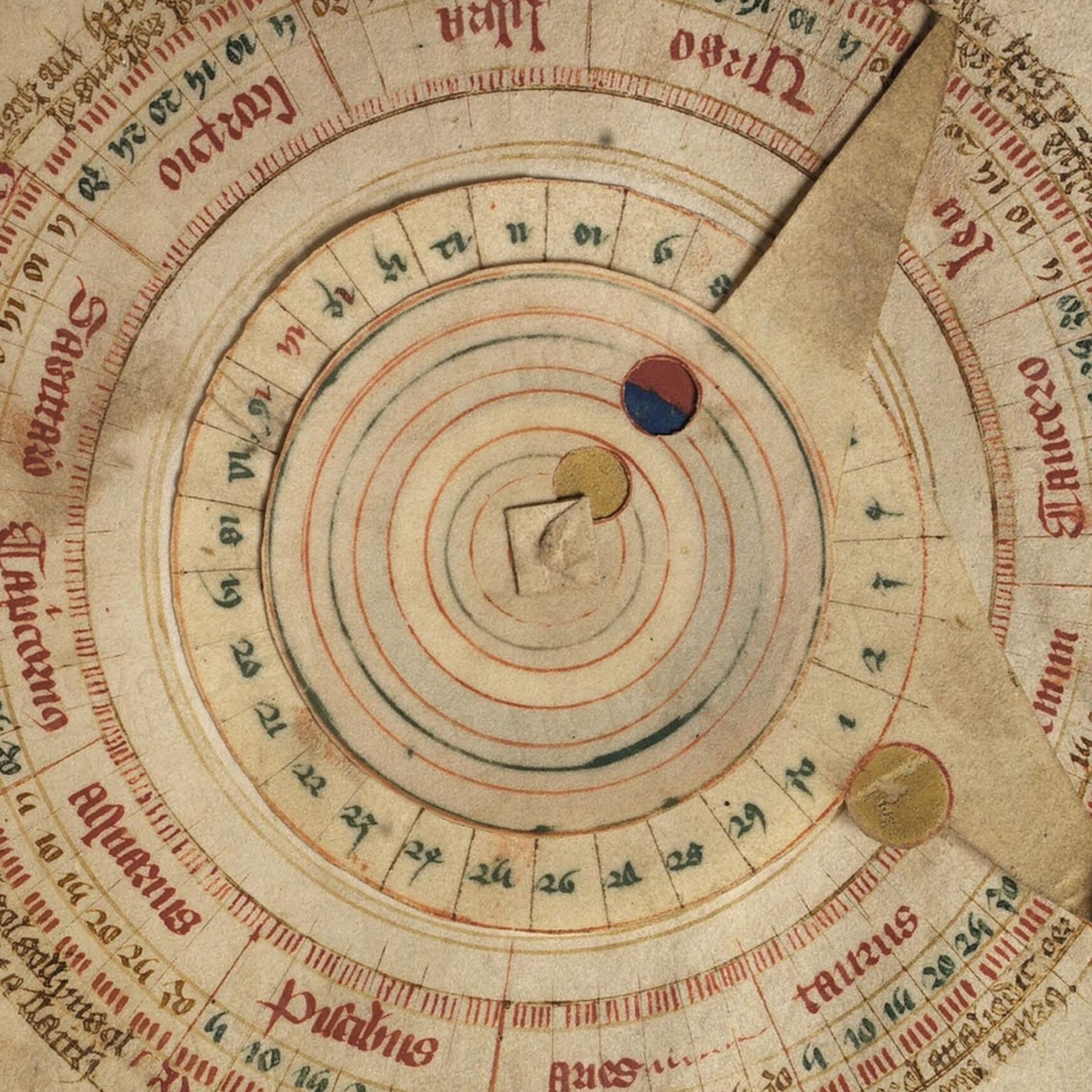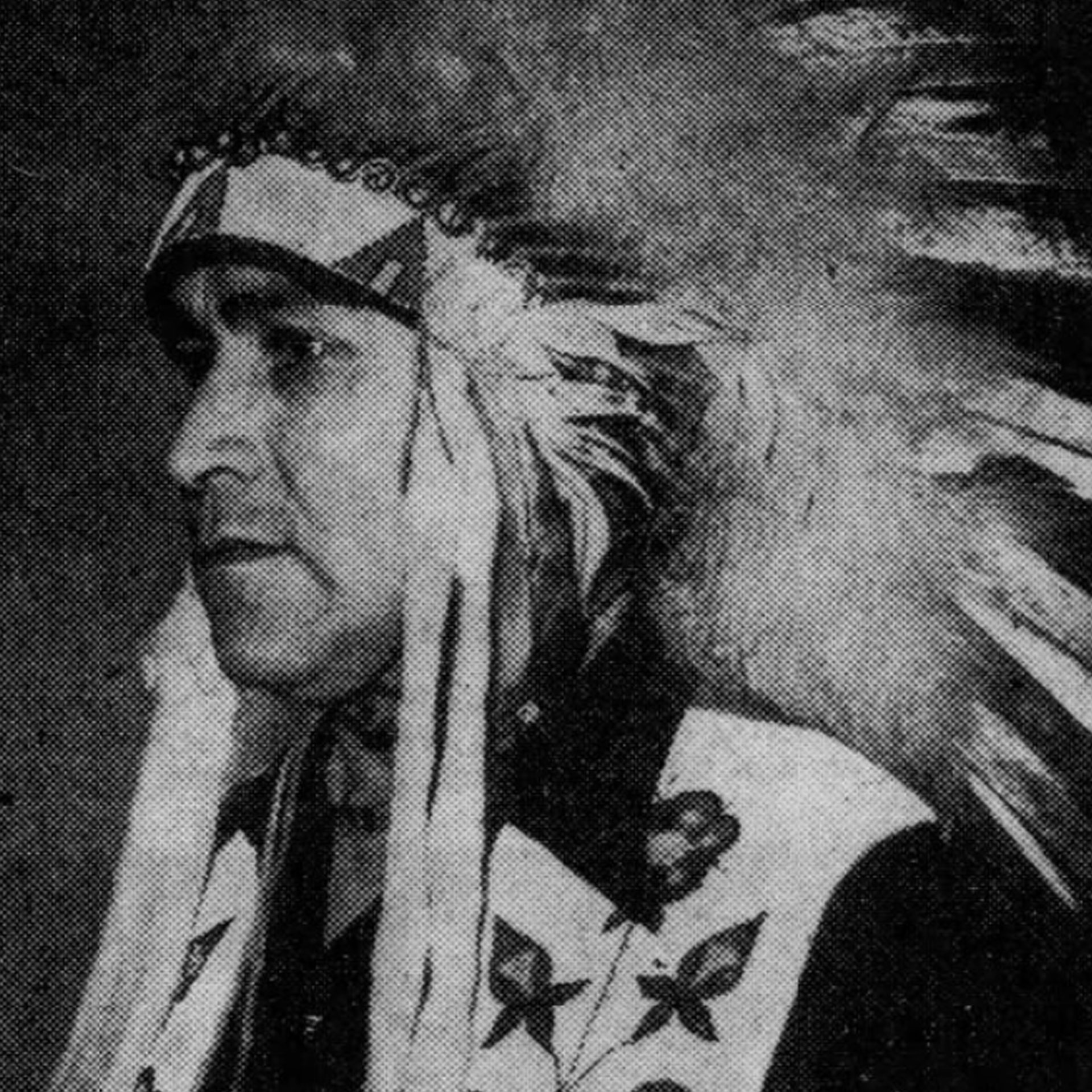
Kulopus
the Q Shaman of 1940
Elwood Towner was born in 1897. Or maybe 1898. Possibly 1899. The records aren’t great. That may be because Elwood was a member of the Hupa tribe, who grew up on the Siletz Reservation outside Pendleton, Oregon.
As a young child, Elwood contracted tuberculosis and spent several years recuperating in a government sanitarium. After his discharge he was enrolled in the Chemawa Indian School, a Native American boarding school in nearby Salem. At the time Chemawa only taught up to grade eight, so he transferred to Salem High School to complete his education.
Elwood appears to have been a popular student. As a sophomore he performed a crowd-pleasing “Indian war dance” in a talent show. As a junior he played the role of Black Eagle in a production of William C. DeMille’s Strongheart: A Battle of Race and Love and received praise for both his performance and his elaborate traditional costume. As a senior he turned his attention to athletics and was a track-and-field and baseball star.
When the United States entered World War I Elwood dropped out to join the Marines. He saw some action in Europe, and after Armistice Day he returned to Salem to finish out his senior year.
After graduating Elwood enrolled in Mount Angel College, then transferred to Willamette University. He played for the college baseball teams during the school year, and in the summers played for local minor league and semipro teams.
Those post-war years seem to have been pretty rough, and Elwood responded by not rising to the occasion.
In June 1923 Elwood was struck by an automobile while walking down a back road and was hurled nearly fifty feet. The resulting injuries to his back and eyes nearly crippled him and required years of expensive medical treatment. (Or maybe not. Elwood continued playing baseball for several years after the accident, and his so-called crippling injuries only emerged a few years later when he needed cash and thought he could get some from a lawsuit.)
In January 1925 a local musician cold-cocked Elwood in the jaw and broke several of his his teeth. (The musician shouldn’t have done it, but it should be noted that Elwood had been drunk and trying to pick a fight with him all night.)
That’s college for you. It’s a time to be young and wild and make stupid mistakes with no consequences.
Elwood received his Bachelor of Law degree from Willamette in June 1926, passed the bar a few months later, and started a modest law practice in Portland.
Though he was only in his late twenties, Elwood was well on his way to being a grumpy old man. He was a frequent writer of letters to the editor, mostly to complain about the kids these days.
That didn’t stop him from marrying one. In April 1928 Elw ood married Evelyn Marie Redpath, who at eighteen was at least eleven years his junior.
Evelyn filed for divorce a year later, claiming her husband had an “ungovernable temper” and had repeatedly slapped her, ripped the clothes off her body, and chased her out of their home. Elwood’s counterclaim accused her of being a slut. In the end he failed to appear in court to plead his case and a default judgement was entered against him, with Evelyn to receive $50/month in alimony plus legal costs.
Astonishingly Elwood continued to file additional pleadings in the case over the next several months, refusing to acknowledge that he had lost or that the court had any authority over him. This was not some stupid mistake. This was a harbinger of things to come.
Deprived of his ability to use wife-beating as an outlet, Elwood instead focused his anger toward political activism.
The American Indian Federation
For the previous forty years the government’s policy towards Native Americans, as enforced by the Bureau of Indian Affairs, had been “extermination through assimilation.” Tribes were confined on reservations, which were maintained only to the bare minimum standard demanded by human decency. Children were shipped off to boarding schools to separate them from their elders, and encouraged to forsake their own traditions for the traditions of their European colonizers.
The system had its critics. One of the most notable was Dr. Carlos Montezuma, a Yavapi Indian who had performed with Buffalo Bill as a youth, attended college and become a successful physician, and, for a time, served as the team doctor for Pop Warner’s Carlisle Indian School football team. Montezuma saw the Bureau of Indian Affairs as a security blanket hiding a pair of shackles, the last step of a centuries-long plan to colonize and exterminate the Native American. He believed the Bureau made tribes dependent on its largesse, perpetuating a culture of helplessness that stifled the Native American intellect and spirit.
Dr. Montezuma’s solution to the problem was simple: the Bureau of Indian Affairs had to go. In many ways, he was the Grover Norquist of Indian Affairs, only concerned with a single issue, consistently pushing the most extreme solution to that issue, and utterly indifferent to the problems that solution might cause.
Montezuma died in 1923, but his ideas were embraced by those who had had thrived in the boarding school system and absorbed its lessons with the zealousness of a convert. These professionals had achieved success in the white man’s world and believed that the only thing preventing others from doing the same was their childlike dependence on the Bureau’s handouts.
Franklin Delano Roosevelt’s victory in the 1932 presidential election gave the assimilationists some cautious hope, especially when FDR appointed John Collier the new Commissioner of the Bureau in 1933. Collier was the first Indian Affairs Commissioner who was actually sympathetic to the plight of the Native American; he had decades of first-hand experience with the reservation system and was full of ideas about how it might be reformed. Working with friendly legislators Collier drafted the Wheeler-Howard Act, more formally known as the Indian Reorganization Act, and more popularly known as “the Indian New Deal.”
The Indian New Deal called for increased tribal sovereignty; for land reforms that would encourage communal ownership; for more funds to improve healthcare and infrastructure on the reservation; and for shuttering boarding schools in favor of local vocational schools.
It proved to be just as controversial as the rest of the New Deal. The Congressional debate grew so heated that one of the bill’s original sponsors, Senator Burton K. Wheeler of Montana, repudiated it. In the end it was only able to squeak through and become a law when someone added a clause allowing individual tribes and reservations to opt out of the program.
Native American public opinion was divided. Many thought the Indian New Deal was the best deal they could possibly get. Others thought it was a good start but did not go nearly far enough. Almost everyone was justifiably wary of anything the white man was offering.
The assimilationists were horrified. They had hoped that the Indian New Deal would weaken the Bureau of Indian Affairs, not strengthen it and spread its tendrils even deeper into the reservation system. They felt the act was downright anti-American, if not outright Communist.
Enter Joseph Bruner, a Creek from Sapulpa, OK. Bruner had done quite well for himself as an oil and real estate magnate. He had a visceral reaction to the act’s expansion of communal property rights, which he perceived as an attack on the American way of life (and of course his own personal livelihood). He would not, could not, let this sort of rank Bolshevism stand.
In 1934 Bruner founded the American Indian Federation (AIF), whose sole goal was to overturn the Indian Reorganization Act. Its activists would delay the implementation of the act by convincing tribes to opt out of its programs; its lawyers would challenged the Constitutionality of the act in Federal court; and its lobbyists would convince Congress to overturn the act.
At its peak the American Indian Federation could claims some 3,500 members nationwide. Its most famous activist was Alice Lee Jemison, a Seneca from New York who wrote about Native American issues as a syndicated columnist for the North American Newspaper Alliance, and who eventually became the Federation’s chief lobbyist in Washington, DC.
Its second most famous member was Elwood Towner.
Elwood was already a well-known advocate for reforming the Bureau of Indian Affairs. He was a regular feature on Portland’s luncheon speaking circuit, where he could be heard decrying how the Bureau was full of waste and mismanagement to rooms full of Rotarians and Odd Fellows and Junior Achievements and whatnot. (The speeches never seemed to mention that his beliefs had only crystallized after he had applied for a job at the Bureau and been rejected.)
He had been an early supporter of the Indian Reorganization Act, but when he realized that the act would expand the Bureau instead of shrinking it he changed his tune. When the American Indian Federation formed in 1934 he became one of its first members.
He now began to argue that the Indian New Deal was Communism in disguise, a blatant attempt to halt the process of assimilation and make Native Americans even more dependent on government handouts. He instead suggested that all Indian boarding schools and reservation schools should be abolished, and young Native Americans forced to assimilate as soon as possible. As a potential role model, he offered up a moderately successful local attorney/wife-beater named Elwood Towner.
These arguments didn’t always go over well. Many were happy to point out that Elwood had personally benefited from the programs he now wanted to abolish, and then suggest that he was a Clarence Thomas-style hypocrite who was trying deny that he had ever relied on anyone else, and then pull up the ladder behind him to prevent others from having the same opportunities.
Which isn’t to say that Elwood didn’t have some success. He was able to convince the Siletz Reservation to opt out of the Indian Reorganization Act, and helped organize a large class action suit against the government for violating its treaty obligations and misappropriating lands and funds that rightfully belonged to the tribes of the Pacific Northwest.
Unfortunately that suit fell apart in 1936 when Elwood realized that, by statute, any damages awarded would not go to the individuals who filed the suit or the tribes they represented, but to the general fund of Bureau of Indian Affairs. His attempts to convince other reservations to reject the IRA fizzled out, as did a lawsuit trying to oust Collier from the Bureau. And another trying to block construction of the Grand Coulee Dam.
The Enemy of My Enemy
It wasn’t just Towner. The American Indian Federation’s attempts to organize were failing all over the country. Their successes were modest at best, while their failures were huge.
Federation activists attempted to turn the tables by becoming increasingly shrill, relying on conspiratorial logic and baseless ad hominem attacks. While testifying before Congress, Jemison attacked Commissioner Collier and Secretary of the Interior Harold Ickes as Soviet stooges with “well-known regard for radical activities and association with, or admiration for, atheists, anarchists, communists, and other fifth columnists.”
The Federation belatedly realized its new strategy was not working, and that it could not go it alone. It began looking for allies.
The problem is that if you are looking for anti-Communist allies, well, there’s no one more rabidly anti-Communist than fascists, and in the 1930s the fascists are literal Nazis. (They are today too, they just hide it better.)
Now, the Nazis were not exactly fans of non-Aryans, but they knew that oppressed minorities could be useful, especially if their grievances could be channeled to into anti-Communist, anti-American, and anti-Semitic directions.
(Nazi leaders also had a strange obsession with Native Americans born out of their love for Karl May’s “Old Shatterhand” novels. Shatterhand was a stoic German cowboy whose Teutonic sense of justice compelled him to wander the American West righting wrongs with his six-guns and his fists and his monosyllabic sidekick Winnetou. The novels were terrible but popular, and raised a generation of Germans who believed that Na tive Americans lived in a perpetual state of noble savagery that made them the next best thing to actual Aryans.)
But I digress.
Nazi propaganda attempted to win over Native Americans by attacking the Indian Reorganization Act as a Communist plot backed by the sinister forces of international Jewry. It made spurious claims that Nazis and Native Americans had a common philosophy, and loved to draw attention to the fact that both groups used the swastika as a symbol. (Hardly surprising, since every culture across the world has some version of the swastika.)
Collier and the Bureau of Indian Affairs attempted to fight back by drily refuting incidental facts without attempting to engage with either the larger arguments or the naked emotional appeal. It wasn’t terribly effective.
Fortunately for Collier, Native Americans were able to easily see through the propaganda because it had been written by people whose knowledge of their culture was based on the trashy pulp novels of a writer so bad he made Ned Buntline look like William Shakespeare. They knew the details were wrong, which made them suspicious of the whole package.
Of course, there were still those who were gullible, desperate, or cynical enough to take the bait.
A surprising number of them were in the American Indian Federation.
Alice Lee Jemison, in particular, received a lot of money from fascists. Her backers included James True, the rabid isolationist who is often credited with coining the phrase “America First”; Henry Allen, the money man for the Revolutionary Mexicanist Action, or “Gold Shirts; “American Führer” Fritz Kuhn of the German-American Bund; and “American Hitler” William Dudley Pelley of the Silver Legion. In exchange for their financial support Jemison spoke at fascist conventions, wrote articles for pro-fascist newspapers, and wrote pro-fascist articles for regular newspapers. When Jemison’s pro-fascist activities became public knowledge in 1939 she was forced to resign from the AIF lest she take the organization down with her.
At least Jemison got to keep her dignity; she did not change who she was, merely tailored her message to her fascist audience.
Elwood Towner could not say the same.
Chief Red Cloud
At some point in 1937 the Bund and the Silver Legion realized that their attempts to recruit Native Americans were not working. The Silver Shirt efforts, in particular, were embarrassingly bad: they started off by introducing their leader as “Chief Pelley of the Tribe of Silver” and it only got worse from there.
Fritz Kuhn and William Dudley Pelley asked Jemison to help them find Native American speakers for their rallies. She gave them the names of several individuals.
In the Pacific Northwest, that was Elwood Towner.
Elwood was not exactly in a great place mentally. His law practice was floundering; he had been all in on that failed class-action suit, and the other irons he had in the fire weren’t panning out. He seems to have coped by drinking and reading Nazi propaganda and beating his second wife, Katherine.
(In fact at one point Elwood beat her so badly she ran out of the house completely naked and made a beeline for the fire station, almost a mile away. The firemen gave her a coat and took her to a hospital where she was treated for cut lips and severe facial bruising. Elwood was arrested, tried and convicted of assault and battery and spent 60 days in jail.)
The fascists may have been a little shocked when Elwood Towner turned up to their rallies in full ceremonial costume: fringed white buckskins, an elaborate beaded vest, and a massive feathered war bonnet made of brilliant white, green, and lavender feathers. Everything was profusely decorated with thunderbirds and swastikas, and just in case the message wasn’t clear enough it also included a Nazi armband.
It seems to have been a form of drag: Elwood was a Hupa, but the outfit was mostly Sioux with a bit of Nazi. It’s not clear whether that was for the benefit of Elwood or his audience. Probably both.
While in costume he was not Elwood Towner but “Chief Red Cloud,” a name clearly chosen to evoke the legendary Oglala chief who had defeated the United States in the 1860s. When he assumed the persona Elwood swallowed his dignity and embraced harmful racial stereotypes, speaking in broken English at a deliberate cadence intended to evoke Native American characters in Hollywood weterns.
As for the content of his speeches…
(Before I get into this, let me stress that what I am about to present is a composite created from several different speeches. The idea is to give you a feel for what Red Cloud was all about rather than fixating on any specific thing he might have said. Also I apologize for the voice but this is exactly how he wanted to sound.)
I am known as kulopus the legal advisor and contact man. I meet with the lodges and secret societies and councils of the Indians. We have a cut-and-dried system of picked men worked out in the southwest and Pacific coast. Alaska, Canada, Mexico, and Central and South America are organized by us.
American Indians must not be afraid of Naziism…
Whether you know it or not Adolf Hitler’s government is established on an Indian model and according to Indian principles…
If the Bund really understood Hitler and could see how he is following the American Indian form of government, the Bund would give the Indian his real place in the movement, which is basic to its success…
Our people admire Hitler for this reason that he adopted for his symbol the swastika. It means prosperity, good luck, and Christian government… Hitler also adopted our salute which means, “Peace be unto you, advance friend.”
Then it was time for a history lesson. You see, Germans and Native Americans had a bond forged in myth and legend. Thousands of years ago Wahnta-Tonka (“the Great Spirit”) foretold that the Germans would come to the New World and join forces with fellow Aryans (for some reason Elwood thought Native Americans were Aryans). Togeth er they would defeat chuck-na-gin, the “Children of Satan” who “were the traditional Aryan enemies, the gold worshippers who would corrupt the Aryan Indians and put them in concentration camps.” In other words, Jews.
Native Americans had warned the Founding Fathers of Jewish treachery. George Washington, Benjamin Franklin, and Thomas Jefferson took this warning to heart and tried to insert a provision in the Constitution expelling all Jews from America, but had been thwarted by that dastardly villain Alexander Ha milton. That had been the beginning of hard times for the Native American.
Now, thanks to the rise of men of like Father Coughlin, Oswald Mosely, William Dudley Pelley, and Fritz Kuhn… you know, “men with guts”… the time for action had come.
[Strike down] the forces of evil, the Reds, the Pinks, and Jews…
All those running the government are Jews…
Communism is Judaism…
The Indians are ashamed of every Senator and Congressman who is licking the bootstraps of that Sephardic Jew in the White House, Franklin D. Rosenfeld. On our reservations we have in training American Indian Hitlers, super-patriots preparing to drive every Jew out of North and South America…
The Indians have always had fascism as their form of government. Democracy is Jewish. It is mob rule. Under the American Indian plan, the rabble will take orders from the real leaders.
Red Cloud claimed Native Americans “from Alaska to Tierra del Fuego” had finally accepted that that the Jews were to blame for “their generally pitiful conditions” and were now ready to acc ept “the Nazi doctrines of violence, rebellion, and race-hatred,” before hitting his crowd-pleasing capper…
We must driv e them [the Jews] into the ocean and destroy them completely.
Red Cloud would then encourage the audience to join a fascist organization (typically the Silver Shirts, since the Bund would only take pure-blooded Germans) and pass out copies of the pro-fascist literature that had been sent to him.
The entire speech came straight out of the Nazi propaganda playbook. Indeed, large chunks of it were paraphrased from The Protocols of the Elders of Zion and the pamphlets of William Dudley Pelley.
Elwood spent the next four years touring the nation as Chief Red Cloud and giving some variation of this presentation.
When Red Cloud spoke to Native American audiences he invariably bombed because his act was embarrassing and Elwood was sus. They did take him seriously enough that more than one tribe passed resolutions attacking Red Cloud as un-American, stressing that he did not represent their point of view, and emphasizing that he was not authorized to speak on their behalf in any way, shape, or form.
White people? They ate up Red Cloud’s act with a spoon. He spoke to rapturous crowds of fascists in Seattle, Spokane, Los Angeles, San Francisco, Phoenix, Washington DC, Alaska, Mexico, and Canada. He had his photo taken standing with unterführer Hermann Schwinn of the Bund and shaking hands with William Dudley Pelley of the Silver Shirts.
In late 1939 word about Red Cloud finally began reaching white people outside of fascist circles. The reaction was uniformly negative, usually served up with a side of utter bafflement.
This resulted in a 1940 confrontation with the Portland chapter of the Anti-Defamation League. When the ADL got wind that Red Cloud was scheduled to speak at Portland public schools, they tried to cancel the engagements and had their attorney, David Robinson, reach out to Elwood so they could talk through their differences.
Elwood refused and then claimed to have been assaulted by a Jew near his home. Then he issued a threat.
You go and tell David Robinson that there is a secret organization of 50,000 people here in Portland that are ready to act at the proper time. Nobody but the members knows anything about it, but it’s going to do plenty when it begins. It has 75,000 members around San Francisco, members in San Jose, Palo Alto, Santa Cruz and other towns in California and about 35,000 members in Seattle. And we know what we are going to do.
There was no evidence for the so-called assault, and even less evidence for Elwood’s extravagant claims about the number of Nazis in Oregon. The papers were not kind to him.
Elwood was eventually pressured into a private meeting with Robinson where he denied having any connections to the Bund or the Silver Shirts, denied having ever endorsed racism or anti-Semitism, denied he had ever said anything subversive or supported overthrowing the government, and even denied that he had a criminal record. Robinson was able to rebut each of these by producing reams of documentation, leaving Elwood flustered and unable to respond.
Did that stop Elwood? Of course not. He said he was only trying to stop the Indian Reorganization Act, and cut off the conversation. Then he went right back to spreading hate, but at least this time he wasn’t doing it in Portland’s public schools.
You know what finally stopped Elwood?
Pearl Harbor. The whole country’s tolerance for Nazi bullshit disappeared overnight. The government and local law enforcement finally started going after fascist groups around the country. Many were shut down, and some survived by going underground.
The American Indian Federation got off lightly. The FBI had long ago concluded that while many of the Federation’s leaders had uncomfortable ties to far-right groups, the Federation itself was still just an advocacy group. (Mind you, the FBI has always been more anti-Communist than anti-fascist so take that decision with a grain of salt.)
Law enforcement may have been willing to let the Federation off the hook, but Collier was able to use those Nazi connections to thoroughly discredit the organization in the court of public opinion. The Federation dissolved in 1945, having failed to achieve any of its goals.
Elwood Towner was not questioned, detained, prosecuted, or persecuted in any way. He was simply too small a fish to bother with.
Small fish or not, he was still a nuisance. In 1941 he represented 71 Yakima men who were seeking exemptions from the draft, on the grounds that they had decided to opt out of the 1924 act which made all Native Americans US citizens. (It’s worth noting that Elwood’s suit did not have the backing of the Yakima Tribe, and when he tried to make the trial a showpiece for his personal beliefs the judge shut him down real fast.)
When that suit failed he decided to keep a low profile for a few years. After the war he re-entered public life, giving speeches and writing editorials, usually going by the name “Buck Towner” in an attempt to obscure his unsavory past.
Elwood’s opinion pieces usually stuck to low-key non-controversial old-man-yells-at-cloud stuff: claiming that there are too many tourists these days, complaining that young people had no appreciation for their elders, and so forth. Though in one particularly galling editorial he attacked the Marshall Plan as wasteful spending then demanded that money be distributed to Native Americans. “Our boys fought and died in two wars or more to preserve this republic and the American way of life against dictatorship,” he wrote, completely ignoring that he been arguing that those boys shouldn’t have to fight, and that he had been all for the dictatorships they had been fighting against.
In the early 1950s he began making presentations about Native American culture to high school students and Indian Guides, dressing up in costume for local pow-wows. (One hopes he had removed the swastikas from his buckskins by then.)
In 1953 he even managed to get named attorney for and temporary chairman of the Hupa Indian General Council.
Then he died on October 6, 1954.
If There’s A Hell Below Then We’re All Gonna Go
What kills me is that Elwood Towner died without showing a shred of contrition, and without suffering any consequences for his actions.
When the crisis is over and the bad guys are defeated there is an understandable desire to act like everything can just go back to normal. We need to resist that urge. No matter how much you want to forgive and forget, you should never forget. Otherwise you will wind up in the same cycle forever.
As for forgiveness, we should be willing to forgive someone if they ask for it, but asking for forgiveness is not just saying, “Please forgive me.” Asking for forgiveness is admitting you did something wrong and actually trying change.
Of course, you can’t lock up everyone who is weakly committed to a bad idea because 100% of the country would be in jail instead of just 1%. So we don’t ask for much.
“I only did it to advance my career and support my family.”
“I didn’t know what they actually stood for.”
“I liked their economic policies but didn’t think they were serious about the other stuff.”
“I didn’t think this would happen.”
These are the little white lies we are willing to accept instead of genuine contrition. It’s not ideal, but you do what you have to do, then hope that you can still look at yourself in the mirror and that history won’t judge you too harshly.
But what do you do with people who can’t even be bothered to do that? People like Elwood Towner?
The problem is that we let them back into the fold. We let ex-Confederates roll back Reconstruction because we needed their votes. We let ex-Nazis run free because we hated Commies more. We let plutocrats run the economy into the ground and then paid off their debts and begged them to do it again. We let revanchists and reactionaries roll back every small bit of social progress.
Elwood Towner was not some apolitical idiot or misled dupe. For four years he took dirty money from the agents of foreign powers to dress up like a character from a terrible Hogan’s Heroes/F-Troop crossover, then went out to tell auditoriums full of cheering Nazis that Jews were the spawn of Satan and they needed to be exterminated. He never showed the least regret for those actions.
Should Elwood have gone to jail? No. In this country you have right to say anything you want, and as far as as I’m aware he did not incite riots or call for anyone to suffer any specific harm. Even when he threatened David Robinson his threats were very carefully worded.
Should he have been disbarred? No. He did a ton of unethical things, but here’s the thing: professional ethics aren’t actual ethics. Elwood’s behavior was reprehensible but not actionable in that sense.
Should he have been a pariah? Damn straight. No newspaper should have been willing to publish his editorials. No civic organization should have been willing to let him speak. People should have shunned him socially and spit on him whenever they passed him on the street.
That didn’t happen, because this country sucks sometimes.
If justice can’t be meted out by the government, if can’t be meted out by our civic institutions, if it won’t be meted out by polite society, there’s only one option left: religion.
So if there is a God in heaven, if there’s any justice in the world, Elwood Towner is rotting in hell.
Connections
Towner is not the first World War I veteran we’ve featured on the podcast. Rondo Hatton, the acromegalic actor best known as “The Creeper,” also saw action in France. (“Monster Without a Mask”)
Towner’s biggest supporter was William Dudley Pelley of the Silver Shirts. We devoted an entire episode to Pelley’s strange journey from novelist to Spiritualist to fascist to UFO cultist. (“Seven Minutes in Heaven”)
And as for Burton K. Wheeler, the one-time sponsor of the Indian Reorganization Act… well, go listen to Rachel Maddow’s Ultra to learn more about him. (Be warned, it’s not fun.)
Sources
- Beekman, Scott. William Dudley Pelley: A Life in Right-Wing Extremism and the Occult. Syracuse, NY: Syracuse University Press, 2005.
- Berger, Knute. “The strange case of the Northwest’s Native American Nazi.” Cascade PBS, 15 Dec 2016. https://www.cascadepbs.org/2016/12/native-american-nazi-chief-red-cloud-elwood-tanner Accessed 1/4/2025.
- Bernstein, Arnie. Swastika Nation: Fritz Kuhn and the Rise and Fall of the German-American Bund. St. Martin’s Press, 2013.
- Green, Rayna. “Native American Women.” Signs, Volume 6, Number 2 (Winter 1980).
- Hart, Bardley W. Hitler’s American Friends: The Third Reich’s Supporters in the United States. Thomas Dunne Books, 2018.
- Hauptman, Laurence M. “The American Indian Federation and the Indian New Deal: A Reinterpretation.” Pacific Historical Review, Volume 52, Number 4 (November 1983).
- Hertzberg, Hazel W. The Search for an American Indian Identity: Modern Pan-Indian Movements. Syracuse University Press, 1971.
- Philip, Kenneth R. John Collier’s Crusade for Indian Reform, 1920-1954. University of Arizona Press, 1977.
- Rosier, Paul C. Serving Their Country: American Indian Politics and Patriotism in the Twentieth Century. Harvard University Press, 2009.
- Townsend, Kenneth William. World War II and the American Indian. University of New Mexico Press, 2000.
- Toy, Eckard V. “Silver Shirts in the Northwest: Politics, Prophecies, and Personalities in the 1930s.” The Pacific Northwest Quarterly, Volume 80, Number 4 (October 1989).
- Wilkinson, Charles F. The People are Dancing Again: The History ofthe Siletz Tribe of Western Oregon. University of Washington PRess, 2010.
- “Alice Lee Jemison.” Wikipedia. https://en.wikipedia.org/wiki/Alice_Lee_Jemison Accessed 02/24/2025.
- “American Indian Federation.” Wikipedia. https://en.wikipedia.org/wiki/American_Indian_Federation Accessed 02/24/2025.
- Nichols, Florence Elizabeth. “Social news.” Oregon Statesman, 28 Apr 1916.
- “Seat sale has been excellent and splendid evening assured.” Capital Journal, 23 Mar 1917.
- “‘Strongheart’ is well played.” Oregon Statesman, 24 Mar 1917.
- “Towner stars in field meet held yesterday.” Oregon Statesman, 11 May 1918.
- “Salem schools hold May Day and meet.” Oregon Sunday Journal, 12 May 1918.
- “25 more register in this county.” Lincoln County Leader, 21 Jun 1918.
- “Fair week.” Lincoln County Leader, 12 Sep 1919.
- “Indian school students elect Arthur Johnson.” Oregon Statesman, 31 Oct 1919.
- “Siletz.” Lincoln County Leader, 23 Dec 1921.
- “Emblems will be given students.” Oregon Statesman, 17 Jan 1922.
- “Siletz.” Lincoln County Leader, 20 Jan 1922.
- “Siletz.” Lincoln County Leader, 22 Feb 1922.
- “College players signed.” Oregonian, 7 Jun 1923.
- “Bush league notes.” Oregonian, 21 Jun 1923.
- “Assault and battery.” Oregon Statesman, 4 Jan 1925.
- “Locals.” Capital Journal, 5 Jan 1925.
- “Pays fine.” Oregon Statesman, 6 Jan 1925.
- “Pastor-Lawyer files first suit.” Capital Journal, 12 Mar 1925.
- “Falls City team wins from Monmouth 10-2.” Capital Journal, 24 Jun 1925.
- “81 graduates at Wilamette monday.” Capital Journal, 12 Jun 1926.
- “Bar examiners pass 67.” Oregonian, 25 Sep 1926.
- “Vancouver licenses.” Oregon Daily Journal, 6 Apr 1928.
- “Locals.” Capital Journal, 6 Apr 1928.
- “Tabloid interviews.” Oregon Statesman, 20 Dec 1928.
- “E.A. Towner sued for separation.” Oregon Statesman, 21 Aug 1929.
- “Locals.” Capital Journal, 31 Aug 1929.
- “Local news briefs.” Oregon Statesman, 24 Sep 1929.
- “Locals.” Capital Journal, 28 Sep 1929.
- “Divorces granted to nine couples.” Capital Journal, 27 Feb 1930.
- “Indian attorney talks to rotary.” Coos Bay Times, 6 Apr 1932.
- “Portland woman hurt.” Oregonian, 18 Jul 1932.
- “Myrtle Point briefs.” Coos Bay Times, 10 Sep 1932.
- Towner, E.A. “Indian leader indorses order.” Oregonian, 1 Jun 1933.
- Towner, E.A. “Would ban the Indian school.” Oregon Daily Journal, 2 Jun 1933.
- “On the air.” Oregon Daily Journal, 16 Jun 1933.
- “The Chemawa crisis.” Capital Journal, 2 Jun 1933.
- “Lo, the poor Indian.” Eugene Register-Guard, 4 Jun 1933.
- “The education of Indians.” Oregonian, 7 Jun 1933.
- “Graduate defends Chemawa.” Oregonian, 8 Jun 1933
- Erwin, Warren A. “Critic owes much to school.” Oregonian, 16 Jun 1933.
- “Indians seek new deal.” Spokesman-Review, 18 Jan 1934.
- “Justice in sight for Indian.” Oregonian, 24 Jan 1934.
- “Indian measure opposed.” Oregonian, 8 Apr 1934.
- “Red men advised to beat new act.” Oregonian, 22 Mar 1935.
- Towner, E.A. “Opposing the Wheeler-Howard act.” Oregon Daily Journal, 3 Apr 1935.
- “Collier attacked by Indian group.” San Diego Sun, 29 Jul 1935.
- “Suit of Indians had futile aim.” Spokesman-Review, 18 Jan 1936.
- “Indians to meet.” Oregonian, 23 Mar 1936.
- “Bonneville Dam ruined fishing, Indians declare.” Daily Herald, 10 Jul 1936.
- “Indians in need of aid, meeting told.” Deseret News, 24 Jul 1936.
- “Indians plan fight to save fishing rights.” Great Falls Leader, 15 Jul 1937.
- “Indian act is ‘a steal’ says Portland attorney.” Great Falls Tribune, 21 Jul 1937.
- “Husband accused.” Oregon Daily Journal, 11 Nov 1937.
- “Garbless woman aided by firemen.” Oregonian, 12 Nov 1937.
- “Amateur burglar paroled to kin; had burglar tools.” Oregon Daily Journal, 12 Nov 1937.
- “Indian to speak.” Oregon Daily Journal, 12 Jan 1938.
- “Towner to speak.” Oregon daily Journal, 28 Feb 1938.
- Humphrey, F.T. “Indian groups at odds over ancient warning by Wanta Tonka, Prophet.” Oregon Daily Journal, 3 Jul 1938.
- “A report on Bund activity in Portland.” Oregonian Magazine, 29 Jan 1939.
- “Patriotic Indians.” Oregonian, 20 Mar 1939.
- Scholz, Richard F. “The Redskins’ new prophet.” Evening Sun, 22 Mar 1939.
- “Chief Red Cloud changes ‘How’ to ‘Heil’ in pro-Nazi speech.” San Diego Sun, 1 Jul 1939.
- “Pact of ’55 to be told.” Oregonian, 8 Aug 1939.
- “Aged Indians seek damages in court.” Eugene Register-Guard, 8 Aug 1939.
- “Yakima Indians seek draft exemption; say they’re not citizens.” Bellingham Herald, 24 Feb 1941.
- “Indians would avoid draft; Yakimas deny citizenship.” Oregon Daily Journal, 25 Feb 1941.
- “Indian council is ‘off’ suit.” Spokane Chronicle, 25 Feb 1941.
- “Hear arguments on Indian suit.” Spokesman-Review, 7 May 1941.
- Towner, Chief Redcloud. “Why ‘Poor Lo’?” Oregon Daily Journal, 16 Apr 1948.
- “Funds sought for Indian aid.” Oregon Daily Journal, 8 Feb 1949.
- Towner, Chief Redcloud. “Tourists are pests.” Oregon Daily Journal, 5 May 1949.
- “Powwow slated.” Oregonian, 20 Oct 1949.
- “Tribe argues payoff boundaries.” Oregon Daily Journal, 14 Mar 1950.
- “Boundary changes asked by Indians.” Medford Mail Tribune, 14 Mar 1950.
- “Coast Indians bicker over tribe boundary.” Corvallis Gazette-Times, 16 Mar 1950.
- “Siletz Indians to revive feast.” Oregon Daily Journal, 12 Apr 1950.
- “Hoopa Indians form new group; map own governmental control.” Times Standard, 15 Jul 1953.
- “Plan Indian delegation to Washington.” Humboldt Standard, 20 Aug 1953.
Links
Categories
Tags
Published
First Published:
Last Edited:
